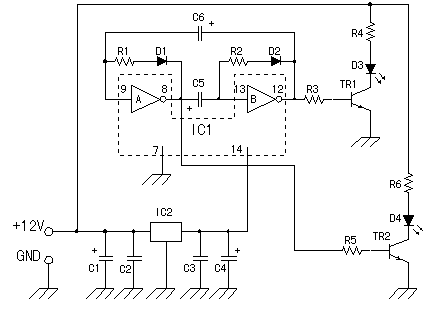
High power siren circuit using CD40106

This is a simple siren sound generator with high power output and significant noise. The circuit utilizes digital ICs, specifically the CD4046, in an inverter configuration, along with four transistors to amplify the current output to a horn speaker rated at 20 watts, compatible with both 4-ohm and 8-ohm loads. When powered, the frequency generator circuit activates, producing a cycle frequency initially set to 1Hz. The output can be modulated using an integrated setup involving additional components. The frequency modulation circuit is driven by IC1/2, R5, and C4, which connects to pin 12 of IC1/2 and feeds into pin 1 of IC1/3. The output from pin 2 connects to IC1/4 and IC1/5, with the outputs from these components driving the base of transistors Q1 and Q2. The circuit design allows for Q1 and Q2 to operate in a switching manner, enabling Q4 and Q5 to pass current through the speakers, while Q2, Q3, and Q6 facilitate current flow through the speakers, generating a loud siren sound. The PCB design is compact, consisting of only two layers. Careful soldering of components, especially ICs and transistors, is crucial, particularly with polarized electrolytic capacitors. This circuit is highly efficient and can be integrated into various theft protection systems, such as home and car alarms. Additionally, an emergency power siren circuit is described, utilizing a digital IC (IC 4011) to produce a frequency pulse generator that emits a warning beep. It employs a power MOSFET to drive an 8-ohm loudspeaker, requiring a 12-volt power supply capable of delivering approximately 1 amp. The circuit design must account for heat dissipation in the power MOSFET.
This siren circuit operates on a principle of frequency modulation to create a loud and attention-grabbing sound, which is particularly useful in alarm systems. The CD4046 IC serves as the heart of the circuit, functioning as a phase-locked loop (PLL) that generates a stable frequency output that can be varied by changing the values of the resistors and capacitors in the circuit. The choice of using four transistors allows for effective current amplification, ensuring that the output to the horn speaker is powerful enough to be heard over significant distances or in noisy environments.
The design's compact nature makes it suitable for applications where space is at a premium, while still offering robust performance. The use of a PCB with only two layers simplifies the manufacturing process and reduces costs. Proper soldering techniques are emphasized to prevent failure, especially with sensitive components like ICs and polarized capacitors, which must be oriented correctly to function properly.
In addition to its application in theft protection systems, this siren circuit can be adapted for various other uses, such as emergency alerts or signaling devices in industrial settings. The flexibility in the design allows for modifications to be made, such as changing the frequency of the output sound or integrating additional features like remote activation or deactivation.
Overall, this siren sound generator circuit exemplifies an effective solution for creating a loud alarm signal, leveraging basic electronic components to achieve a significant auditory output, with potential applications in security and emergency response systems.This is a simple siren sound that high power output and very noisy. ICs, Digital ICs are easy to use number CD4046 Inverter circuit and four transistor power increase current out to horn speaker 20 watt 4ohm 8ohm. Operation of the circuit when the circuit is connected to power. Frequency generator circuit starts, the cycle will be the second fr equency generator set to a first set of IC1 / 1, R2, C2 generator frequency 1Hz. Output can be modulated. With integrated suite 2, which is R3, R4, C3, ZD1 the modulation and frequency of Set 2 is the origin of IC1 / 2, R5, C4 are the output out of pin 12 of IC1 / 2 to Pin 1 of IC1 / 3. The output from the pin 2 is connected to IC1 / 4, IC1 / 5 and pin B of the Q1 output of IC1 / 4, IC1 / 5 is connected to pin B of Q2.
we can observe that Q1 and Q2 will run switch. Well, if work makes Q1 Q4, Q5 run a current through the speakers and will work if Q2 Q3, Q6 running a current flowing through the speakers. The nature of the circuit of Q3-Q6 will result in high currents flowing through the speakers, the sound of the siren is very loud.
As said at the beginning of the subject that. The PCB of the project have very small size just two stamps only. If not believe, then take a look at Figure 2. Really high efficient. Who wants to be redesigned to be smaller. Device should be soldered onto the PCB carefully, especially IC, transistors. And equipment such as polar Electrolytic capacitors, must be correct. Certifies that, this circuit of course works. This is a super siren is small. It can be applied compatible with various theft protection circuit, decidedly For example, to prevent a home burglary, car theft protection, or want to use a different alarm sirens. This be Emergency power siren Circuit 6 watt sizes. It use Digital IC number IC 4011 perform produce the frequency pulse generator, be beep danger character.
And have power mosfet wasp use a loudspeaker 8 ohm sizes and are large-sized loudspeaker. for have a voice as the last. For power supply Source use 12 Volt sizes that have can give current get tall about 1 Amp a little like and Power Mosfet should hold let off the heat with. The detail is other, friends, see in the circuit has yes. 🔗 External reference
This siren circuit operates on a principle of frequency modulation to create a loud and attention-grabbing sound, which is particularly useful in alarm systems. The CD4046 IC serves as the heart of the circuit, functioning as a phase-locked loop (PLL) that generates a stable frequency output that can be varied by changing the values of the resistors and capacitors in the circuit. The choice of using four transistors allows for effective current amplification, ensuring that the output to the horn speaker is powerful enough to be heard over significant distances or in noisy environments.
The design's compact nature makes it suitable for applications where space is at a premium, while still offering robust performance. The use of a PCB with only two layers simplifies the manufacturing process and reduces costs. Proper soldering techniques are emphasized to prevent failure, especially with sensitive components like ICs and polarized capacitors, which must be oriented correctly to function properly.
In addition to its application in theft protection systems, this siren circuit can be adapted for various other uses, such as emergency alerts or signaling devices in industrial settings. The flexibility in the design allows for modifications to be made, such as changing the frequency of the output sound or integrating additional features like remote activation or deactivation.
Overall, this siren sound generator circuit exemplifies an effective solution for creating a loud alarm signal, leveraging basic electronic components to achieve a significant auditory output, with potential applications in security and emergency response systems.This is a simple siren sound that high power output and very noisy. ICs, Digital ICs are easy to use number CD4046 Inverter circuit and four transistor power increase current out to horn speaker 20 watt 4ohm 8ohm. Operation of the circuit when the circuit is connected to power. Frequency generator circuit starts, the cycle will be the second fr equency generator set to a first set of IC1 / 1, R2, C2 generator frequency 1Hz. Output can be modulated. With integrated suite 2, which is R3, R4, C3, ZD1 the modulation and frequency of Set 2 is the origin of IC1 / 2, R5, C4 are the output out of pin 12 of IC1 / 2 to Pin 1 of IC1 / 3. The output from the pin 2 is connected to IC1 / 4, IC1 / 5 and pin B of the Q1 output of IC1 / 4, IC1 / 5 is connected to pin B of Q2.
we can observe that Q1 and Q2 will run switch. Well, if work makes Q1 Q4, Q5 run a current through the speakers and will work if Q2 Q3, Q6 running a current flowing through the speakers. The nature of the circuit of Q3-Q6 will result in high currents flowing through the speakers, the sound of the siren is very loud.
As said at the beginning of the subject that. The PCB of the project have very small size just two stamps only. If not believe, then take a look at Figure 2. Really high efficient. Who wants to be redesigned to be smaller. Device should be soldered onto the PCB carefully, especially IC, transistors. And equipment such as polar Electrolytic capacitors, must be correct. Certifies that, this circuit of course works. This is a super siren is small. It can be applied compatible with various theft protection circuit, decidedly For example, to prevent a home burglary, car theft protection, or want to use a different alarm sirens. This be Emergency power siren Circuit 6 watt sizes. It use Digital IC number IC 4011 perform produce the frequency pulse generator, be beep danger character.
And have power mosfet wasp use a loudspeaker 8 ohm sizes and are large-sized loudspeaker. for have a voice as the last. For power supply Source use 12 Volt sizes that have can give current get tall about 1 Amp a little like and Power Mosfet should hold let off the heat with. The detail is other, friends, see in the circuit has yes. 🔗 External reference





